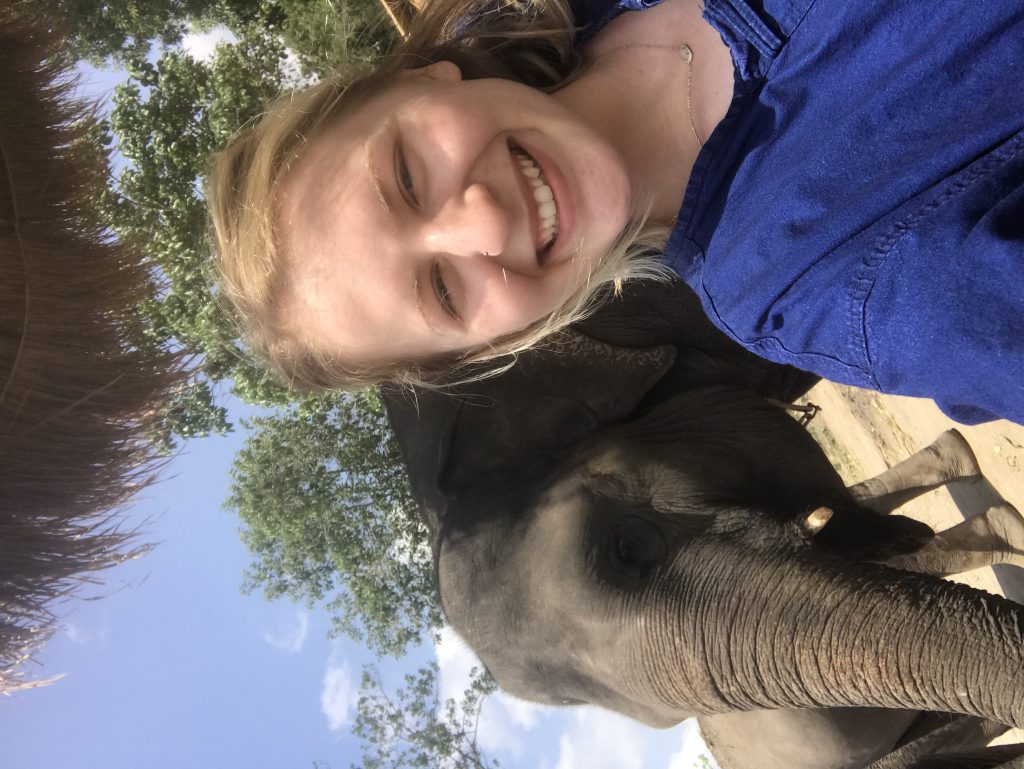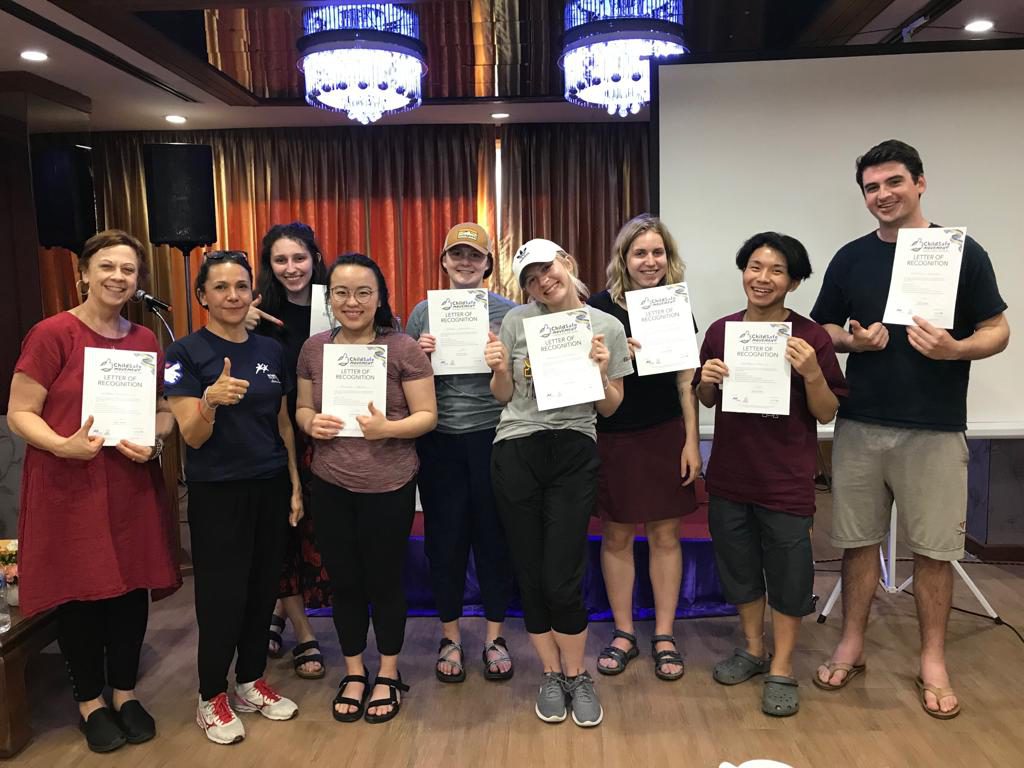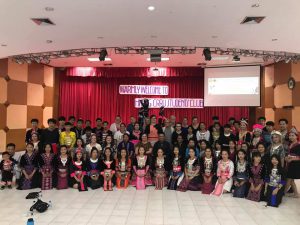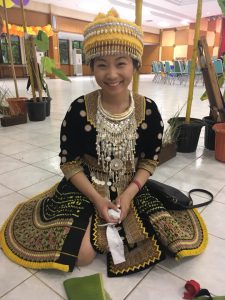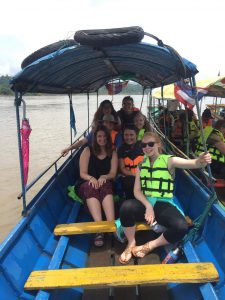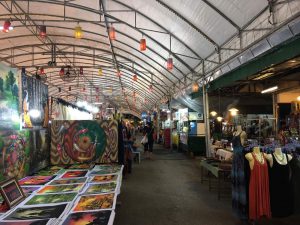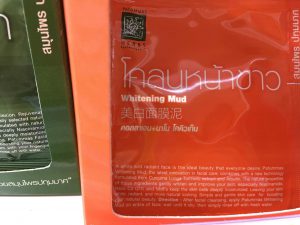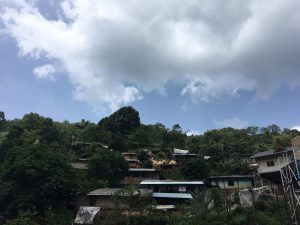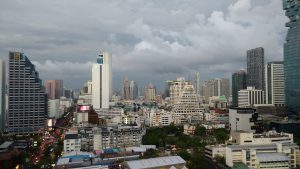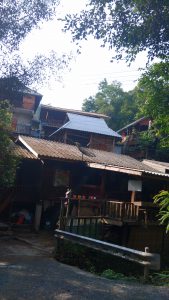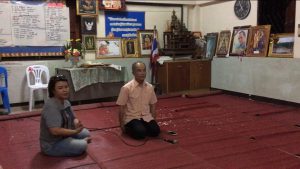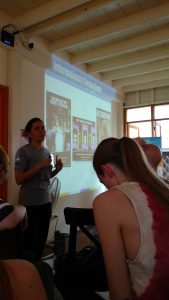Mai Chia Lee, Molleysa Yang, Wennicha Yang, Deeh Chah, Sia Thao, George Vang
Acharn Cathy
FSOS 4150 – Global Change, Community, and Families in Thailand
03 June 2017
Thailand Education: Observations, Research, and Reflection
Throughout these past three weeks, we learned a lot about Thailand’s education system through village visits and engaging with students and staffs. Surprisingly, we arrived in Thailand during the start of their school year – May. Traditional Thai Schools begin their schooling from May to March, and have about 200 days of school (Clark 2014). Throughout our trip, we visited two schools: Suksasongkroh Chiang Dao Boarding School at Chiang Dao, Chiang Rai, and a Hmong elementary and middle school at Bahn Thung Na Noy, Chiang Khong. At Chiang Dao, we met many energetic, happy, and passionate high school students who dreamed of becoming teachers, auto mechanics, pharmacists, nurses, and tour guides. At the Hmong elementary and middle school, we met many eager students who were not sure about who they wanted to be in the future, but were hopeful in keeping what they already have – smiles, laughter, and culture.

(Above) Suksasongkroh Chiang Dao Boarding School
Chiang Dao, Chiang Rai: The students are in their traditional clothes as it was a Friday.
(Below) Bahn Thung Na Noy, Chiang Khong: The Hmong students joined the UMN-TC students in doing the Cupid Shuffle as a cultural exchange activity
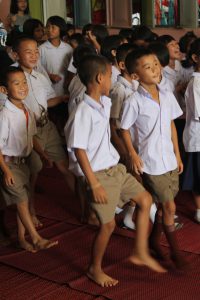
A typical day of schooling differs between institutions for students. At Chiang Dao, a boarding school for vulnerable youth ages 7 – 18, students wake up at 4:40am to exercise and clean their dorms. They are served breakfast at 7:00am, begin school at 8:00am, and end school at 4:30pm. After school, students have dinner at 5:00pm, relaxation at 7:30pm, and bedtime at 9:00pm. Very differently, the Hmong elementary and middle school begin school at 8:00am and end school at 4:00pm. Since their school is located at their village – versus the Chiang Dao Boarding School – many of the children are able to come home and live with their family. As the Thai government provides free education for all students ages 7 – 18, we will begin to explore how these students are supported by their staffs, families, and government, and struggles we noticed throughout our visits.
Many Thai students receive emotional support from their families. From our visits to Chiang Dao and centers such as the Mekong Child Rights Protection Center in Chiang Khong, Chiang Rai, we learned that most hill tribe and poor Thai students do not live with their families during school sessions. They get to visit their families for at least 1-2 months during breaks. I (Deeh) believe that parents of these students value education, thus, allowing their young children to live away from them in order to attend school. From my personal experience, my parents sent my older sister and me to live with our aunt in another village to get an education when we were still in Thailand. Furthermore, many Thai students receive educational support from governmental decision makings. According to a Hmong uncle from the Hmong Christian village, Pha Nok Kok, it is Thai law for children to be in school by age 9. If a child is not in school by 9 years old and the Thai government finds out, the parents will be arrested because they are preventing their children from getting an education. One reason for such action is, according to our meeting at the Hill Area Development Foundation in Chiang Rai, many hill tribe families want their children to farm and support the families. However, most families want their children to be educated. Therefore, this law ensures that every child in Thailand obtains an education and are not left behind.
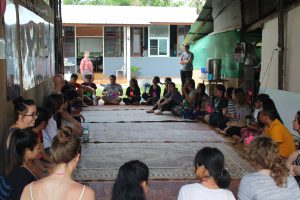
(Above) Child Rights Protection Center: The girls and UMN-TC students are doing fun activities together.
Although Thai students are given support to go to school from their families and government, there is barriers and discrimination that they have to face in their process of obtaining an education. According to the article, Educate a Child, “In 2011 13.1% of the [Thai] population still live below the poverty line and 80% of these population live in rural area where the benefit of their economic success has not reached all area as equally as it should.” Although the Thai government provides free education for students, some families cannot afford to send their children to school because they do not have transportation funds. Additionally, not every school nearby is public – meaning free education. From many of our village visits, we learned that there is not always a school nearby, which can also be a reason to why some families do not send their children to school. Fortunately, schools like Chiang Dao School support the hill tribe families who cannot afford to send their children to school. They welcome vulnerable and impoverished children to boarding schools where they live and learn until they have graduated. At Chiang Dao School, many things are provided free for them such as education, food, uniform, dormitories, school supplies, hospital visits, and etc by the help of the government. Therefore, some families do not have to struggle financially to provide these items for their children. However, not every student attends a school like Chiang Dao, and not everyone goes to a boarding school.
Other barriers and discrimination that many hill tribe students face would be the language barrier and assimilation. For migrant students who do not understand the instructed Thai language, they are likely to drop out, according to Mr. Som Chai, the chief of the Huay Hea Village. When hill tribe students attend school with their traditional ethnic name, many adopt a Thai name because their Thai teachers and students cannot pronounce it. Many of these students instead are given a Thai name from their Thai teachers. This act is problematic because it teaches non-Thai children to lessen the value of their ethnic name, and to become more Thai. As hill tribe students learn more Thai, many forget how to speak their native language, as experienced when we met Hmong students at the Chiang Dao School.
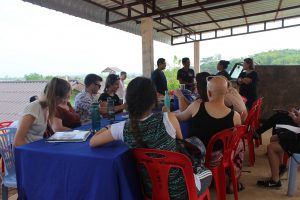
(Above) Huey Hea Village: UMN-TC students are learning how difficult life can be without Thai citizenship, for example, from Mr. Som Chai.
In addition to barriers and discrimination that many hill tribe students face, tribal students have minimal role models to look up to at school because there are not many staff members who are of their ethnic background, and faculty members who speak their ethnic language. Moreover, students who are not citizens of Thailand are not able to attend a University; they can only attend school up to 12th grade. There is not enough scholarship and government funds to help them throughout college.
During our visit to the Pha Nok Kok village, I (George) learned about assimilation in the Thai Schooling community. Their chief told us many struggles of the Hmong people. According to the village chief, the one thing that parents struggle with is having their child talk in Hmong after returning from school. Many of their children are forced to talk in Thai during their time in school and have little time to speak their native language. Over a period of time, they forget how to speak their language. Not only are they forced to learn the Thai language, but they also learn about Thai culture. After graduating from high school, most of the children stay in the cities to work and do not have time to visit their families at home. This prevents a lot of the minorities to keep their identity because of how immersed they are with the Thai culture.
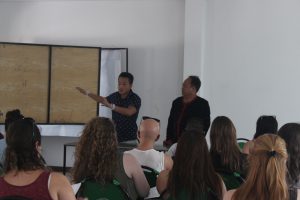
(Above) Pha Nok Kok: The chief shared about their village life while Sia did the translation for the class.
When we visited the Hill Area Development Foundation and Huay Hea village, we learned that the Thai teachers gives no effort in pronouncing a student’s name and thus, gives them a new name. The villagers are trying to work with the school to fix this problem because they’re aware of their child losing their identity and culture. From our experience in the United States, we have never experienced a teacher giving their students new names. They give an effort to learn a student’s name no matter how difficult it is to pronounce.
It was amazing to see that education in Thailand is highly valued in all the areas that we’ve explored, and I (Sia) am positive that it is also valued throughout Thailand as well. However, I noticed that Thailand’s educational system is excluding multiculturalism, leading to an imbalance between the students’ education about their ethnic history, culture, and language and the Thai history, culture, and language. As a result, most students do not know about their history, their culture, and, like we’ve mentioned above, is losing their native language.
According to all the teachers and students that we have interviewed, only Thai history is taught in school. Many Hmong-Thai students that I have talked to had little to no clue about their history at all; some seemed to have never even thought of their history before. Those who knew about their history only heard them from the conversations of their elders. It’s sad to see that many Hmong-Thai students do not have a lot of knowledge about their history anymore. While I do not know much about other ethnic minorities’ reaction to their history because I was not able to communicate with them as much, I believe that they are also facing similar situations regarding to the Hmong. Without history, we would not know where we came from and how we came to be where we are today. This could easily lead to identity challenges and many other issues. While I have not done an in-depth research about the Thai educational system and its implementation of ethnic minorities’ history, from what I have seen so far I feel sad and upset that the Thai educational system seems to be seclusive to ethnic minorities’ history. The situation with culture for ethnic minorities is similar to their situation with history.
Due to the lack of transportation offered by the government for students, if students do not have transportation to school then they will either have to quit, go live near their school, or go to a boarding school. Because ethnic minorities mostly live on the mountains and/or far away from schools, they lack transportation. Moreover, they are usually poor and cannot move to urban areas for their children’s education. Therefore, many minority students are sent off to live alone or to boarding school. This distance between them and their family decreases the connection between his/her culture until he/she goes back to the village (which a lot of students nowaday do not go back to because there is no job offered at their village). In addition, with no classes at school to teach about different cultures in Thailand, I believe that students’ interest in studying and learning about their culture and other cultures will slowly diminish.
Like the sub-chief of Pha Nok Kok said to us in the discussion, he has seen students lose their culture and convert to other cultures; if he did not call and check up on his kids regularly, he believes they would probably lose their culture and language, too. This was evident at Suksasongkroh Chiang Dao school. When I talked to the Hmong-Thai students at Suksasongkroh Chiang Dao school and asked them about their culture, they were not able to provide a lot of knowledge. It was understandable because they have been at the boarding school instead of home for many years. It saddens that they do not have the chance to learn about their culture and its many beautiful practices. It saddens me even more that Thailand has no multicultural trainings for teachers. Thailand is populated with many ethnic minorities but there are no trainings for teachers to learn how to deal and manage the diverse population of their students. While there are organizations such as the Hill Area Development Foundation that works to help minority students to adjust to Thai culture and language while maintaining theirs, it would be great if there are more support for the preservation of students’ culture, and workshops that helps Thai teachers become more multiculturally censored in their workplace.
Thailand also does not offer classes about ethnic minorities’ languages. The Thai educational system offers only Thai and foreign languages. As a result, minority students are slowly losing their native language. The Hmong-Thai students at Suksasongkroh Chiang Dao school and Sunflower House shows that. From seeing and speaking with the Hmong students they seem to retain their culture well, but not their native language. Students that I’ve talked to cannot speak their native language without using Thai words in their sentence; they are not able to communicate solely with their native language. Of course, there are words that the Hmong language cannot convey without using Thai, but the words that these students are using Thai to talk to me were simple Hmong words or phrases that can be easily said without using Thai. On the other hand, Hmong students at Bahn Thung Na Noy’s school, a school in a Hmong village, were able to maintain their native language fairly well. They were able to communicate what they wanted to say solely in Hmong to me.
To conclude, multiculturalism is excluded in the Thai educational system. Due to that, there are no classes offered about the minorities’ history, culture, and language, creating an imbalance between the minority students’ education about their history, culture, and language and the Thai’s history, culture, and language. This resulted in many students not knowing about their history, their culture, and losing their native language. I really hope that NGOs and community organizations will keep making positive impacts in Thailand’s education, to the point that multiculturalism will be implemented.
In Thailand, there are other opportunities and repercussions that present itself when children do not have a formal education. Students of poverty who cannot attend formal schools, classroom-based and provided by trained teachers, are likely to turn to other forms of education, labor work, or sex work. Examples of other forms of education are vocational schooling. Child Safe is one of the organizations that we have met with and learned about the vocational training for youth in Thailand. According to Marie from Friends International, vocational training provides a stepping stone and the experience needed for youth to enter the workforce at hotels and restaurants. Employers are more likely to be interested in these students because they would have already had hands on experience, and gained interpersonal skills that would benefit these industries. Child Safe is offered to youth who are poor and not eligible to enter elementary and middle school because of their age. Child Safe aims to find children of poverty who are vulnerable to child trafficking for labor and sex work, and teach them skills that will lead them towards a brighter future.
Another opportunity open to children who can not attend school is labor work. However, from the villages that we have gone to, it seems like there are a lot of support for children to attend school. We did not see a lot of young people at most villages that we visited because they are attending school. This is only a scratch of the surface of what we’ve seen though. According to a speaker from the Hill Area Development Foundation, some tribal ethnic groups have lots of children where many of these children decide to stay to help their parents. As we have mentioned above about how some families do not have enough money for transportation and such, their children turn to help families with labor work, farming, and handicrafts.
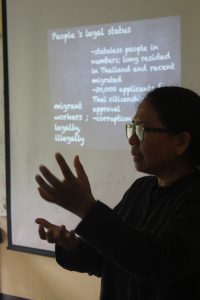
(Above) Hill Area Development Foundation: Juthamas, the director, talks about the NGO history and projects that they do to serve hill tribe students and communities.
Lastly, we learned about sex trafficking as a repercussion for not having formal education. Desperate and no direction for income, some girls are lured into sex work. According to P’Eve, our tour guide, girls are deceived about work and follow the recruiters back into the cities. After being sexually exploited and learning about the lie, they return to their village with a huge amount of money for their family. This then attracts other girls to do the same, when they believe that there is a promising opportunity for work. This is one of the heartbreaking repercussions of not having enough support for the school.
Our visit to Thailand has been immensely powerful as we connected with schools, students, staff members, and the culture. Many of the Thai students are very passionate about their education because they want to have more opportunities than what they have already, and become great leaders for their families and the future. Many of the Thai institutions we visited were very passionate and intentional about their work as well – doing their best to make sure that students are not being trafficked, and are receiving necessary skills to thrive in their communities. Although it is governmental law for all students to attend a formal education, there are still students who fall through the cracks – especially those who live in the countryside, away from the city life; not all villages have a school nearby, and families can struggle to send their children to school due to the distance and being low income. Moreover, many school institutions do not teach their students enough to value the ethnic minority identities that are present at their schools, such as the Hmong, the Lahu, and the Karen. The main culture that is taught is Thai and a bit of Western, which can cause many hill tribe groups to lose a piece of their culture, such as their language. Although there are many things that we would like to see Thailand work on, being able to visit Thailand and their schools have been a beautiful privilege for us all. It has been a fortunate experience to step into a land that values education very deeply, and we are looking forward to bringing our learning to our communities back at home.
References:
Clark, N. (Ed.). (2014, March 3). Education in Thailand. Retrieved May 26, 2017, from http://wenr.wes.org/2014/03/education-in-thailand

